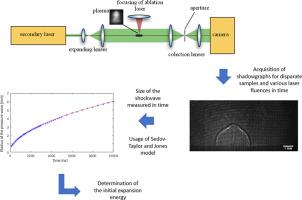Spectrochimica Acta Part B: Atomic Spectroscopy ( IF 3.2 ) Pub Date : 2021-07-10 , DOI: 10.1016/j.sab.2021.106254 Jakub Buday 1 , Pavel Pořízka 1, 2 , Marcela Buchtová 3, 4 , Jozef Kaiser 1, 2

|
Laser-induced plasma (LIP) is dependent on many experimental conditions, as well as on the material and type of the ablated sample. Typically, the spectral data from a LIP are used as an analytical tool. However, the problem is that the data suffer from instability of the plasma, matrix effect, shot-to-shot fluctuation, etc. One of the possibilities how to improve the performance of LIBS is a deep understanding of behaviour of the plasma at various times during its evolution. Therefore, we used shadowgraphy setup to observe the shockwave created by the explosion during ablation of the sample. Our goal was to observe differences in shadowgraphy data for four different samples, each of them with unique matrix. Then, we aimed to use the shadowgraphy data to calculate the initial energy of the expansion. For each sample, we used various laser energies between 7 and 50 mJ. Sedov-Taylor model was applied as it fit the measured data. The model accurately fitted the experimental data up to 1.3 μs from the ablation of the sample. For further time delays, a slightly different approach was proposed, using model's equation with a changed power exponent. Later, Sedov-Taylor and Jones models were employed to calculate the initial energy of the shockwave. The calculation revealed a similarity in the amount of energy that was needed to ablate steel and glass sample. As for the ablation of bronze and soft tissues, approximately half of that energy was needed. These results were then compared with thermal properties of the samples, where similar results can be seen.
中文翻译:

在激光诱导击穿光谱中用阴影法测定初始膨胀能
激光诱导等离子体 (LIP) 取决于许多实验条件以及烧蚀样品的材料和类型。通常,来自 LIP 的光谱数据用作分析工具。然而,问题在于数据受到等离子体的不稳定性、基质效应、射击到射击的波动等的影响。 如何提高 LIBS 性能的可能性之一是对等离子体在不同时间的行为的深刻理解在其发展过程中。因此,我们使用阴影成像设置来观察样品烧蚀过程中爆炸产生的冲击波。我们的目标是观察四个不同样本的阴影成像数据的差异,每个样本都有独特的矩阵。然后,我们旨在使用阴影数据来计算膨胀的初始能量。对于每个样本,我们使用了 7 到 50 mJ 之间的各种激光能量。应用 Sedov-Taylor 模型,因为它适合测量数据。该模型准确地拟合了样品烧蚀后长达 1.3 μs 的实验数据。对于进一步的时间延迟,提出了一种稍微不同的方法,使用具有改变的幂指数的模型方程。后来,Sedov-Taylor 和 Jones 模型被用来计算冲击波的初始能量。计算表明,烧蚀钢和玻璃样品所需的能量相似。至于青铜和软组织的消融,大约需要一半的能量。然后将这些结果与样品的热性能进行比较,可以看到类似的结果。该模型准确地拟合了样品烧蚀后长达 1.3 μs 的实验数据。对于进一步的时间延迟,提出了一种稍微不同的方法,使用具有改变的幂指数的模型方程。后来,Sedov-Taylor 和 Jones 模型被用来计算冲击波的初始能量。计算表明,烧蚀钢和玻璃样品所需的能量相似。至于青铜和软组织的消融,大约需要一半的能量。然后将这些结果与样品的热性能进行比较,可以看到类似的结果。该模型准确地拟合了样品烧蚀后长达 1.3 μs 的实验数据。对于进一步的时间延迟,提出了一种稍微不同的方法,使用具有改变的幂指数的模型方程。后来,Sedov-Taylor 和 Jones 模型被用来计算冲击波的初始能量。计算表明,烧蚀钢和玻璃样品所需的能量相似。至于青铜和软组织的消融,大约需要一半的能量。然后将这些结果与样品的热性能进行比较,可以看到类似的结果。Sedov-Taylor 和 Jones 模型被用来计算冲击波的初始能量。计算表明,烧蚀钢和玻璃样品所需的能量相似。至于青铜和软组织的消融,大约需要一半的能量。然后将这些结果与样品的热性能进行比较,可以看到类似的结果。Sedov-Taylor 和 Jones 模型被用来计算冲击波的初始能量。计算表明,烧蚀钢和玻璃样品所需的能量相似。至于青铜和软组织的消融,大约需要一半的能量。然后将这些结果与样品的热性能进行比较,可以看到类似的结果。











































 京公网安备 11010802027423号
京公网安备 11010802027423号